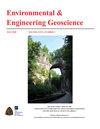活性物质对煤转化过程中污染物去除效果的研究
IF 0.7
4区 工程技术
Q4 ENGINEERING, ENVIRONMENTAL
引用次数: 1
摘要
渗透反应屏障(PRB)技术是目前发展最为迅速的一种保护土壤和水体不受污染的技术。这些屏障是充满活性物质的区域,污染物在其中被固定和/或在受污染的地下水流动期间其浓度降低到极限值。本文研究了煤地下气化(UCG)工艺后处理水中污染物的去除效率。试验是在实验室中使用流动式反应器设计进行的。后处理用水来自于在波兰Mikołów的芭芭拉矿进行的UCG实验。实验以活性煤、沸石、纳米铁为反应原料。所得结果与具有严格定义特征的参考水(人工水)进行的试验进行了比较。研究表明,活性炭是反应区用于去除煤转化过程中产生的地下水中有机污染物的最有效材料。新的特点是在UCG过程中,在地质反应堆区域使用PRB,以限制在不受控制和不可预测的操作情况下,在与气体泄漏到环境中的紧急情况下,在地下火灾期间,以及被高毒性物质污染的水中,污染扩散的潜在风险。本文章由计算机程序翻译,如有差异,请以英文原文为准。
The Effectiveness of Reactive Materials for Contaminant Removal in the Process of Coal Conversion
The technology of permeable reactive barriers (PRB) is one of the most frequently developed methods for protecting soil and water from pollution. These barriers are zones filled with reactive material in which contaminants are immobilized and/or their concentration is reduced to the limit values during the flow of contaminated groundwater. This article presents a study on the efficiency of the removal of contaminants from the post-processing water from the underground coal gasification (UCG) process. The tests were carried out in a laboratory using a flow-through reactor design. The post-processing water came from a UCG experiment carried out in the Barbara mine, Mikołów, Poland. Activated coal, zeolite, and nano-iron were used as the reactive materials in the experiment. The obtained results were compared to tests carried out with reference water (artificial) with strictly defined characteristics. Research has shown that activated carbon is the most effective material used in the reaction zone for removing organic contaminants from groundwater generated during the coal conversion process. A new feature is the use of PRB in a georeactor zone during the UCG process to limit the potential risk of contamination spreading in the case of uncontrolled and unpredictable operation, in emergency situations related to gas leaks into the environment, during underground fires, and for water polluted by high-toxicity substances.
求助全文
通过发布文献求助,成功后即可免费获取论文全文。
去求助
来源期刊

Environmental & Engineering Geoscience
地学-地球科学综合
CiteScore
2.10
自引率
0.00%
发文量
25
审稿时长
>12 weeks
期刊介绍:
The Environmental & Engineering Geoscience Journal publishes peer-reviewed manuscripts that address issues relating to the interaction of people with hydrologic and geologic systems. Theoretical and applied contributions are appropriate, and the primary criteria for acceptance are scientific and technical merit.
 求助内容:
求助内容: 应助结果提醒方式:
应助结果提醒方式:


